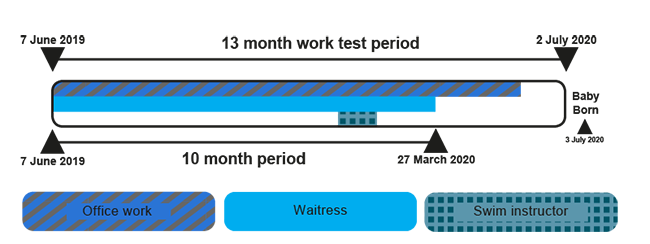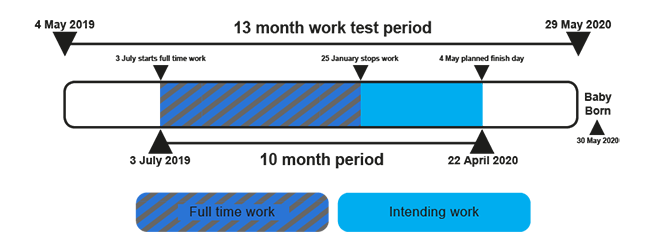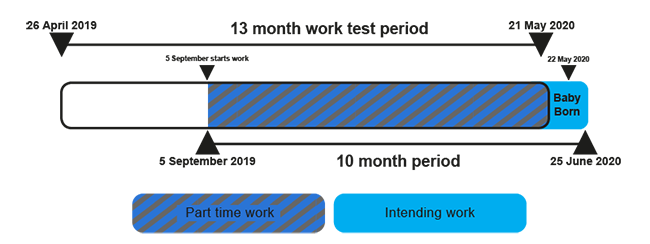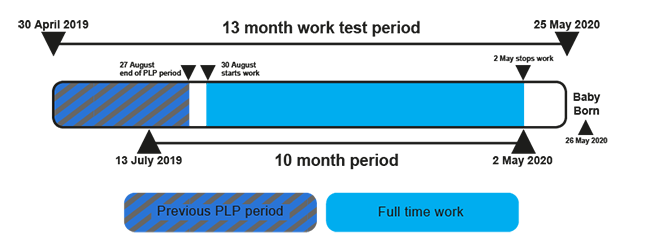on this page
- When you take paid leave from work
- When you have different employers
- When you have pregnancy related illness or complications
- When you have a premature birth
- When you have a previous Paid Parental Leave period
- When you’re self employed
- When you have a gap between work days
- When you have a dangerous job
- When you got income from JobKeeper Payment
- When you got COVID-19 Disaster Payment
These examples don’t cover every situation. Read about the Parental Leave Pay work test for more information.
When you take paid leave from work
Alison had her baby on 18 August 2020. Her 13 month work test period is from 23 July 2019 to 17 August 2020. This is the day before she had her baby.
During that time Alison worked 38 hours per week, full time and took 13 weeks of paid leave. She returned to work for 5 weeks after this leave. She then started 3 weeks paid maternity leave from 28 July 2020. Alison’s paid leave counts as work, for the work test.
Alison worked for a 10 month period from 23 July 2019 to 12 May 2020. She worked more than 330 hours and didn’t have a gap of 12 weeks or more between work days.
Alison meets the work test.

When you have different employers
Jenna had her first child on 3 July 2020. Her 13 month work test period is from 7 June 2019 to 2 July 2020.
Jenna worked for a 10 month period from 7 June 2019 to 27 March 2020. During that time, Jenna worked for 3 employers.
Jenna was working in an office for 6 hours every Monday. She did a total of 258 hours from the beginning of her work test period until 27 March 2020.
Jenna worked as a waitress with casual hours. She calculated that between 7 June and 27 March she worked a total of 70 hours.
Jenna also worked as a swimming instructor for 3 hours per week. She did this for 4 weeks in February 2020 for a total of 12 hours.
Jenna can include her work with each employer towards the work test.
Jenna has worked more than 330 hours in the work test period. There isn’t a gap of 12 weeks or more between 2 working days in the 10 month period.
Jenna meets the work test.

When you have pregnancy related illness or complications
Patricia was on unpaid leave for 2 years before she started full time work. She worked full time from 3 July 2019 to 25 January 2020. Her baby was due on 3 June 2020.
She planned to work until 4 May 2020, but had to stop work early because of pregnancy related complications. She had her baby prematurely on 30 May 2020.
Her 13 month work test period is from 4 May 2019 to 29 May 2020. The test period ends the day before she had her baby, not the day before her baby was due.
Patricia’s 10 month period is from 3 July 2019 to 22 April 2020. In this period Patricia worked more than 330 hours. However, there’s more than a 12 week gap between 2 work days.
Patricia gave us evidence that her doctor told her to stop work. She also gave us evidence from her employer that she’d planned to work until 4 May 2020.
Patricia meets the work test.

When you have a premature birth
Denise was working 8 hours per week since 5 September 2019.
Denise’s baby was due on 4 August 2020 but she had her baby prematurely on 22 May 2020. Her 13 month work test period is from 26 April 2019 to 21 May 2020. The test period ends the day before she had her baby, not the day before her baby was due.
Denise calculated that she worked 296 hours from 5 September 2019 to 21 May 2020. This is less than 330 hours in the 10 month period.
Denise intended to work up to 25 June 2020, more than 6 weeks before her due date. This would have resulted in her working additional hours and meant she worked over 330 hours.
Denise gave us evidence from her doctor of her child’s expected due date. She also gave us evidence from her employer that she planned to continue working up to 25 June. The evidence included the number of hours Denise would have worked.
Denise meets the work test.

When you have a previous Paid Parental Leave period
Sadie was on maternity leave for her first child. She got Parental Leave Pay for the period from 24 April to 27 August 2019.
Sadie returned to work on 30 August 2019 for 35 hours per week. She stopped work on 2 May 2020 to have her second child.
Sadie had her second child on 26 May 2020. Her 13 month work test period is from 30 April 2019 to 25 May 2020.
Sadie can include her previous period of Parental Leave Pay and her paid work towards the work test. This means she’s worked more than 330 hours in the 10 month period from 13 July 2019 to 2 May 2020. There was also no more than a 12 week gap between work days.
Sadie meets the work test.

When you’re self employed
Lisa runs a business from home, which she started in March 2019. Due to start up and running costs, Lisa hasn’t made a profit from her business yet. She worked at least 4 days per week for 5 hours per day.
Lisa had her first child on 30 April 2020. Her 13 month work test period is from 4 April 2019 to 29 April 2020.
Lisa’s 10 months period is from 4 April 2019 to 23 January 2020. During this time she worked more than 330 hours without more than a 12 week gap.
Lisa meets the work test.

When you have a gap between work days
Zara had her baby on 6 January 2020. Her 13 month work test period is from 10 December 2018 to 5 January 2020.
During that time, Zara worked 15 hours a week. Between 20 June 2019 and 21 August 2019 she took 9 weeks of unpaid leave. Zara’s unpaid leave doesn’t count as work for the work test. She stopped work on 5 December 2019 to have her baby.
Zara has worked more than 330 hours in the 10 month period from 14 February 2019 to 5 December 2019. There was also no more than a 12 week gap between work days.
Zara meets the work test.

When you have a dangerous job
Joanne was working as a jockey. Her job description required her to train and race horses.
Joanne had her baby on 1 December 2020. She stopped work on 5 April 2020 because workplace hazards were a risk to her pregnancy. This meant Joanne had a gap of more than 12 weeks between work days. Joanne does not meet the normal work test that ends the day before she had her baby.
We asked Joanne to provide proof from her employer confirming she was working as a jockey. She also provided the industry regulations which set out when a jockey can work during pregnancy.
Joanne was able to meet the Dangerous Jobs provision. We moved her 13 month work test to an earlier period. Her new work test period ends on 5 April 2020, the day she stopped work.
Joanne worked more than 330 hours in the 10 month period between 16 June 2019 and 5 April 2020. She had no more than a 12 week gap between each work day.
Joanne meets the work test in the earlier period.

When you got income from JobKeeper Payment
Indira had her baby on 12 October 2020. Her 13 month work test period is from 16 September 2019 to 11 October 2020.
Indira was working 1 day a week at a café until 29 March 2020. Between 30 March 2020 and 31 May 2020 Indira’s employer paid her income from JobKeeper Payment. Indira wasn’t working during this time. From 1 June 2020, Indira returned to work 8 hours on Fridays. She continued to get income from JobKeeper Payment.
Indira stopped working and stopped getting income from JobKeeper Payment on 4 August 2020.
We’ll count the period Indira wasn’t working, but was getting income from JobKeeper Payment in her work test. We count it as 7.6 hours for each weekday, which is Monday to Friday.
For the period Indira was working and getting income from JobKeeper Payment, we count both:
- 8 hours for each Friday, because Indira worked more than 7.6 hours
- 7.6 hours for each day, Monday to Thursday, because Indira worked less than 7.6 hours on these weekdays.
Indira can count more than 330 hours in the 10 month period from 15 October 2019 to 4 August 2020. This includes when she got income from JobKeeper payment. There was also no more than a 12 week gap between work days.
Indira meets the work test.

When you got COVID-19 Disaster Payment
Li Yu had her baby on 1 September 2021 in Sydney during lockdown. Her 13 month work test period is from 5 August 2020 to 31 August 2021.
She was working part time in retail from 25 October 2020 to 25 June 2021 when the store at which she worked closed down. Li Yu got COVID-19 Disaster Payment from 26 June 2021 to 31 August 2021.
Li Yu could count the COVID-19 Disaster Payment in her work test. She counted it as 7.6 hours for each weekday, which is Monday to Friday.
When she included the COVID-19 Disaster Payment, Li Yu met the work test because both the following applied:
- she worked more than 330 hours in the 10 month period between 10 November 2020 and 31 August 2021
- she didn’t have a gap more than 12 weeks between work days.
